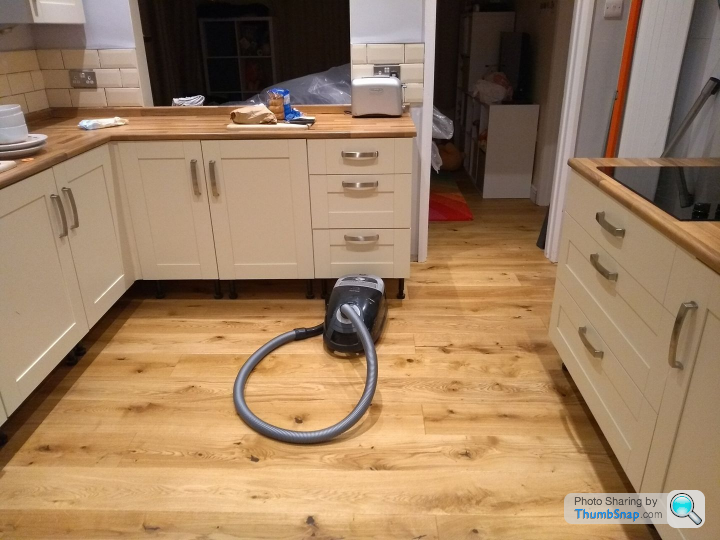Advice on levelling a floor
Discussion

We have a bit of a challenge in our 70s ex-bungalow which I'd appreciate some advice on.... We've fitted oak engineered flooring throughout, and I was planning on doing the same in our kitchen. We've done a fair chunk of work in the house, so in terms of funds this seemed like a pragmatic choice. The plan was to go wall to wall & not have plinths.
The challenge is that the floor in this room is reasonably flat, but it has a significant slope from left to right. Across 3.15 metres there's probably 22mm to 25mm drop. It's most noticeably raised on the left of the picture - 900mm along the left wall (so looking at an area of 3.375sqm).
Raising the entire floor with levelling compound would make it higher than the other rooms.
I'm considering using an 125mm angle grinder, vacuum shroud, masks and Diamond Grinder Disc (https://www.amazon.co.uk/Diamond-Grinder-Disc-Wheel-Cuttig/dp/B01BYFTKCS/) to take out some of the height on the left of the picture and use levelling compound on the right of the picture. There's probably a few mm in the existing flooring on it's own. The room size is 3.15m (in pic) by 3.75m. I could also cut slots using a normal diamond blade.
Has anyone tried this ? Is it feasible to drop the height using an angle grinder in this way ?
Chris Type R said:
There aren't any tiles.
Laying engineered flooring left to right without leveling will result in bounce.
No it won't. There are two ways of describing it: Laying engineered flooring left to right without leveling will result in bounce.
1. Out of level, non horizontal.
2. Straight (or not?)
You can have both straight and out of level on the same floor as per your pic and description.
You'd be a glutton for major punishment if you tried to level a concrete floor the way you are describing I know that.
Chris Type R said:
jas xjr said:
why not just lay an engineered wooden floor on top of the tiles?
There aren't any tiles.Laying engineered flooring left to right without leveling will result in bounce.
i am sure somebody more experienced will be along shortly. i have laid many houses full of flooring and would no worry. unless of course i do not understand the problem , which is usually the case

I had a similar problem putting down engineered floor in our hall - 1960's built with a couple of large flints 'poking up' - I either had to grind them down or raise the whole floor, so I did the former........ lots of dust and swearing, but I got it good. Even with a fine tolerance (<5mm) and the correct 'underlay' and an edge gap the engineered floor still creaks in the summer, and has a bit of a bow in the winter - I had to plane all the doors due to extra thickness as well, and new threshold strips. I wish I'd just chosen laminate floor, as good laminate now is just about 'invisible' with no pattern repeat etc, hard-wearing and (importantly) will IMHO keep it's shape/tolerate temperature changes better.
Chris Type R said:
I think it's a bad idea, just trying to get a sanity check re. how bad 
I can lose some height by taking up part of the lino and ommiting some of the underlay...
do you already have the new flooring ? if so perhaps you could have a dry run from side to side just to see if it is possible. my bodgers way would be to leave the lino down and put the underlay on top 
I can lose some height by taking up part of the lino and ommiting some of the underlay...

Yes I have the flooring. If you look at the photo top right you can see the ajoining room which I did a few weeks ago. This was quite easy to level out as the dips were mainly in the corners.
Ultimately (few years time) these two rooms will become one.
My experience has been that the more even the sub floor, the less creaky the floating floor (even, not necc. level).
I can use the flooring elsewhere, so it won't go to waste.
Ultimately (few years time) these two rooms will become one.
My experience has been that the more even the sub floor, the less creaky the floating floor (even, not necc. level).
I can use the flooring elsewhere, so it won't go to waste.
So, in the end I just went for it, without any levelling. The end result is 'okay', as the carcasses hold the floor down - just some creaks I need to try and get some oil into. There is a discernible slope - which makes finding marbles easier.
It'll do until I can afford a proper kitchen, and a tiled floor with underfloor heating (the plan is to open out what's left of the dividing wall & move the 50cm 3 drawer plus another to the right hand side - extending the countertop).

It'll do until I can afford a proper kitchen, and a tiled floor with underfloor heating (the plan is to open out what's left of the dividing wall & move the 50cm 3 drawer plus another to the right hand side - extending the countertop).

Gassing Station | Homes, Gardens and DIY | Top of Page | What's New | My Stuff



